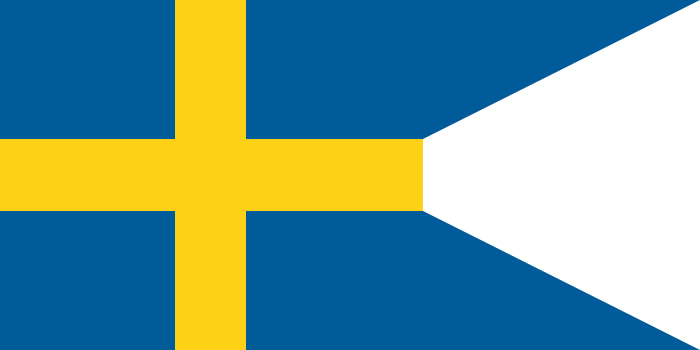'New Sweden' 1638 - 1655
The 17th century saw Sweden's brief turn as a European "superpower" and one of the Continent's major military and political combatants during the Thirty Years' War.
-
 Johan Björnsson Printz, governor of New Sweden from 1643 to 1653
Johan Björnsson Printz, governor of New Sweden from 1643 to 1653 -
-
By mid-century, Sweden’s borders included part of Norway and all of Finland, and stretched into Russia. Sweden’s control of portions of modern Poland, Latvia, Estonia, Lithuania and Germany made the Baltic Sea essentially a Swedish lake, as someone once put it.
-
 Flag of Sweden at the time of New Sweden, Delaware. (The swallow-tailed flag was used between the reign of Gustav I of Sweden until approximately 1650, when it was succeeded by a triple-tailed flag.)
Flag of Sweden at the time of New Sweden, Delaware. (The swallow-tailed flag was used between the reign of Gustav I of Sweden until approximately 1650, when it was succeeded by a triple-tailed flag.) -
-
Perhaps inspired by the riches its rival nations garnered from overseas colonies, Sweden, too, sought to extend its reach to the New World. In 1637, Swedish, Dutch and German stockholders formed the New Sweden Company to trade for furs and tobacco in North America. Under the command of Peter Minuit, former governor of the Dutch colony New Netherlands, the company's first expedition sailed from Sweden with two ships, the Kalmar Nyckel and the Fogel Grip.
-
The ships reached the Delaware Bay in March 1638, and the settlers began to build a fort at the site of present-day Wilmington. They dubbed it Fort Christina in honor of Sweden's twelve-year-old queen. It was the first permanent European settlement in the Delaware Valley.
-
Over the next 17 years, twelve more Swedish expeditions left their homeland for New Sweden. A total of eleven vessels and some 600 Swedes and Finns reached the colony, which eventually consisted of farms and small settlements along both banks of the Delaware River in modern-day Delaware, New Jersey, Pennsylvania and Maryland.
-
New Sweden reached its greatest heights during the governorship of Johan Printz (1643-1653). He extended settlement northward from Fort Christina along both sides of the Delaware River and improved the colony's military and commercial prospects by building Fort Elfsborg. Near present-day Salem on the New Jersey side of the river, the fort protected the river from English and Dutch ships. Despite these measures, the Swedish and Finnish colonists lived peacefully with their Dutch and native American neighbors.
-
Unfortunately, Governor Printz's autocratic rule left many settlers dissatisfied. An 1653 petition for reform was branded a "mutiny," but did succeed in sending the Governor packing for Sweden.
-
Printz was succeeded by the colony's final governor, Johan Rising. Soon after arriving in New Sweden n 1654, Rising attempted to remove the Dutch from the region by seizing Fort Casimir (present-day New Castle, Del.), which lay below Fort Christina on the western shore of the river. With no gunpowder to launch a defense, Fort Casimir surrendered without a shot and was re-named Fort Trinity by the Swedes.
-
But Rising had not reckoned with retribution of Peter Stuyvesant, the hot-tempered governor of the Dutch colony. The furious Stuyvesant had his revenge the following summer, when seven armed Dutch ships and 317 soldiers appeared on the Delaware River. Realizing that resistance would be futile, the vastly outnumbered Swedes surrendered Fort Trinity. Governor Rising surrendered Fort Christina two weeks later.
-
Swedish sovereignty over New Sweden was at an end, but the Swedish and Finnish presence continued to be much in evidence. In fact, Stuyvesant permitted the colonists to continue to operate as a “Swedish Nation.” They were free to be governed by a court of their choosing, to practice their religion, to organize their own militia, to retain their land holdings and to continue trading with the native people. This continued until 1681, when Englishman William Penn received his charter for Pennsylvania and with it the three lower counties that make up present-day Delaware.
-
The Swedish colonial society
Descendants to the early settlers and historians have founded an organization - The Swedish Colonial Society, founded in 1909, to:
Collect, preserve and publish materials relating to the history of the Swedes and Finns in America; Maintain parks, monuments and memorials of historic sites; and Commemorate historic events and accomplishments.
More information, see: Colonial Swedes -
At the turn of the century, few descendants of the early Swedes and Finns knew much about their ancestors or the history of the New Sweden Colony. In 1906, Dr. Amandus Johnson returned from study in Europe with a wealth of material concerning New Sweden on the Delaware and a determination that the history of the first colonial Swedish settlement in America should be recorded. In 1907, Dr. Johnson met with Swedish officials in the United Statesto generate support for the creation of a national organization and, during 1908, several informal meetings were held at the Historical Society of Pennsylvania with prominent individuals who shared Dr. Johnson's vision. On January 20, 1909, the organizational meeting of the Swedish Colonial Society took place. On July 13, 1909, H. M. Gustaf V, King of Sweden, accepted the invitation to become the first High Patron of the Society, a position now held by the present King of Sweden, H.M. Carl XVI Gustaf.
-
-
